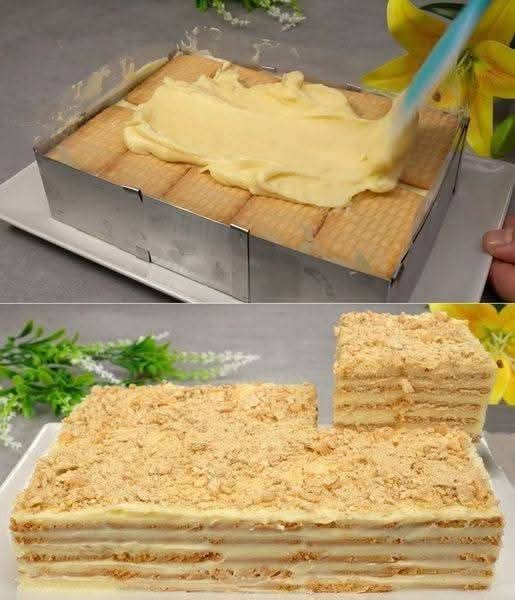Introduction
If you’ve ever enjoyed a creamy layered dessert that seems to melt in your mouth, you’ve probably come across Pavê. This Brazilian favorite is one of the most beloved no-bake desserts in Latin cuisine. Its name comes from the French word pavé, meaning “paving stone,” which makes sense when you look at its layered structure—rows of cookies and cream stacked neatly like little blocks.
Pavê is a staple at family gatherings, birthdays, and festive holidays because it is simple to make, requires few ingredients, and can be customized in endless ways. The texture is what sets it apart—soft layers of cookies that soak up the creamy filling, creating a rich and velvety dessert that’s both comforting and elegant.
Below, we’ll explore a step-by-step guide to making pavê, along with tips, variations, and answers to common questions.
Ingredients You’ll Need
For the Cream Base
- 3 large eggs
- 3/4 cup sugar (180 g)
- 1/2 cup all-purpose flour (70 g)
- 2 1/2 cups milk (600 ml)
For the Butter Cream Mixture
- 3/4 cup (1.6 sticks) unsalted butter, at room temperature (180 g)
For the Layers
- 7 oz (about 1 1/4 cups) cookies of your choice (200 g)
For Decoration
- Crumbled cookies for garnish
Step-by-Step Instructions
Step 1: Mix the Ingredients
In a large bowl, beat the eggs with sugar until smooth and uniform. Slowly sift in the flour while whisking to ensure there are no lumps.
This forms the base of the cream and ensures that the mixture thickens properly later.
Step 2: Cook the Cream
Pour the milk into the egg-sugar-flour mixture. Transfer the mixture to a saucepan and cook over medium-high heat, stirring constantly with a whisk.
Keep stirring until the cream thickens into a custard-like consistency. The key is to avoid lumps by never stopping the stirring motion.
Once ready, set the cream aside to cool to room temperature.
Step 3: Whip the Butter
In a separate bowl, beat the butter until pale, light, and fluffy (about 2–3 minutes). Slowly add the cooled cream into the butter mixture, a spoonful at a time, while continuing to beat.
This step gives pavê its signature silky-smooth texture.
Step 4: Assemble the Pavê
Prepare a 10×6-inch glass dish (or similar).
- Place a layer of cookies at the bottom.
- Spread a layer of cream evenly over the cookies.
- Repeat the process, alternating cookies and cream, until you have five layers of each. End with cream on top.
Step 5: Refrigerate
Cover the dish with plastic wrap and refrigerate for at least 5 hours, preferably overnight. This allows the flavors to meld and the cookies to soften into the cream, creating that irresistible pavê texture.
Step 6: Decorate and Serve
Before serving, crumble some cookies on top for decoration and crunch. You can also dust with cocoa powder, add chocolate shavings, or top with fresh berries for a modern touch.
Slice into squares or scoop out portions with a spoon—and enjoy!
Tips for the Perfect Pavê
- Choose the Right Cookies: Traditional pavê often uses maizena cookies (similar to ladyfingers), but you can use Maria cookies, digestive biscuits, or even chocolate cookies for variation.
- Let It Rest: The longer pavê rests in the fridge, the better the texture. Overnight refrigeration is best.
- Flavor Boost: Add a splash of rum, coffee, or vanilla extract to the cream for depth of flavor.
- Lighter Version: Substitute some butter with whipped cream for a lighter, mousse-like finish.
- Serving Idea: Pavê looks extra elegant when made in individual glass cups for parties.
Variations of Pavê
Pavê is versatile, and different flavors can be created with small changes:
- Chocolate Pavê: Add melted chocolate or cocoa powder to the cream mixture.
- Fruit Pavê: Incorporate fresh strawberries, peaches, or pineapple between the layers.
- Coffee Pavê: Dip cookies briefly in strong coffee before layering for a tiramisu-like twist.
- Nutty Pavê: Add layers of crushed nuts like walnuts or almonds for extra crunch.
FAQs
1. What kind of cookies should I use for pavê?
Classic pavê uses ladyfinger-style cookies or simple tea biscuits, but you can get creative with chocolate cookies, graham crackers, or even Oreos.
2. Can pavê be made ahead of time?
Yes! In fact, pavê tastes better when made a day ahead since the cookies soften and absorb the cream.
3. How long does pavê last in the fridge?
Properly stored, pavê will last about 4–5 days in the refrigerator. Keep it covered to prevent it from absorbing other fridge odors.
4. Can pavê be frozen?
Freezing is not recommended since the cream may separate after thawing. It’s best enjoyed fresh from the fridge.
5. Can I make pavê without butter?
Yes, but the texture will be lighter. Replacing butter with whipped cream gives it a fluffier, mousse-like consistency.
6. Is pavê similar to tiramisu?
In a way, yes. Both are layered desserts using cookies/biscuits and creamy fillings, but pavê usually has a custard-based cream and doesn’t always include coffee or alcohol.
Conclusion
Pavê is more than just a dessert—it’s a celebration of family, gatherings, and comfort food. Its creamy, layered goodness brings together simple ingredients to create something indulgent yet easy to make.
The balance of cookies and cream, combined with the endless possibilities for flavor variations, makes pavê a dessert you’ll want to revisit again and again. Whether you stick to the traditional recipe or experiment with chocolate, fruits, or nuts, one thing is certain—this dessert will always be a crowd-pleaser.
So the next time you need a make-ahead treat that’s rich, elegant, and satisfying, try making this classic pavê. One bite, and you’ll understand why it’s a beloved staple in Brazilian kitchens.

